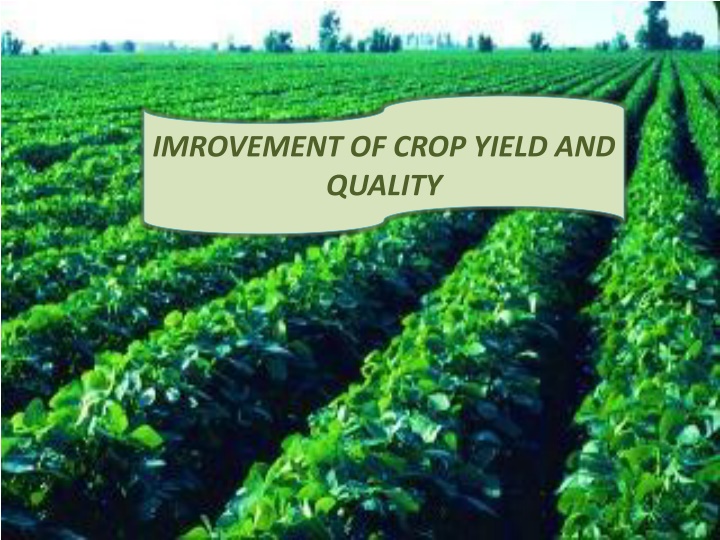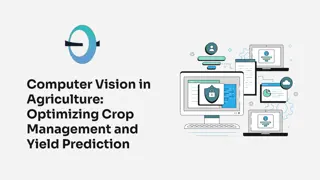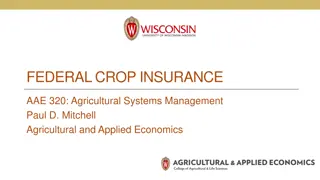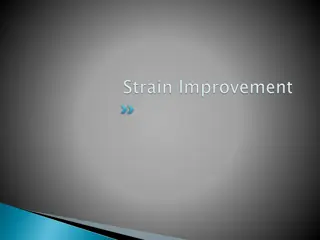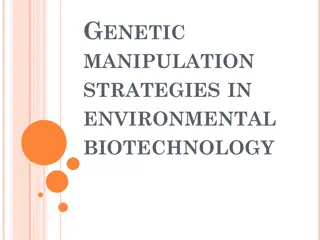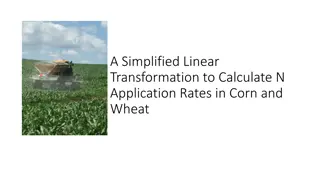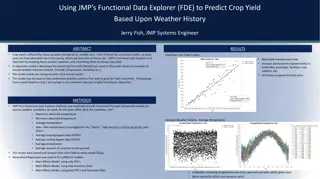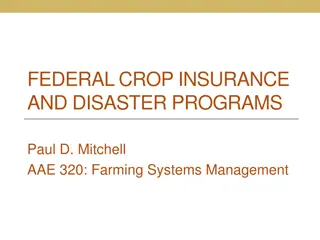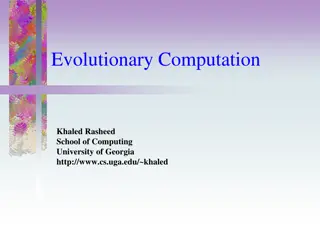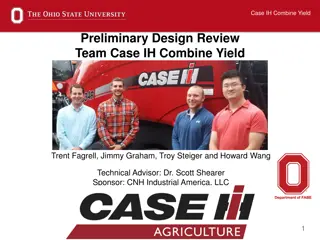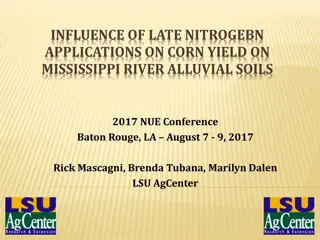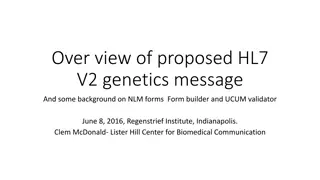Enhancing Crop Yield and Quality Through Genetic Manipulation
This chapter explores methods to improve crop productivity and quality through genetic enhancements such as increasing yield and improving plant material quality. It discusses factors influencing crop productivity, such as solar radiation and photosynthetic efficiency, and factors determining crop quality, including nutritional quality and flavor. The genetic manipulation of fruit ripening, specifically in tomatoes, is also discussed, highlighting the use of specific genes like pTOM6 and pTOM13. Antisense technology is introduced as a method to delay ripening in transgenic tomatoes, aiming to provide supermarket tomatoes with better taste and appearance.
Download Presentation

Please find below an Image/Link to download the presentation.
The content on the website is provided AS IS for your information and personal use only. It may not be sold, licensed, or shared on other websites without obtaining consent from the author.If you encounter any issues during the download, it is possible that the publisher has removed the file from their server.
You are allowed to download the files provided on this website for personal or commercial use, subject to the condition that they are used lawfully. All files are the property of their respective owners.
The content on the website is provided AS IS for your information and personal use only. It may not be sold, licensed, or shared on other websites without obtaining consent from the author.
E N D
Presentation Transcript
IMROVEMENT OF CROP YIELD AND QUALITY
In the previous chapters we have seen how crop productivity can be enhancing their ability to resist external factors improved by There are endogenous factors also that effect crop productivity and quality of harvestable plant material In this chapter we will find that how productivty can be genetically enhanced by: Increasing the amount Improving the quality of plant material
The yield of a crop is determined by: Intercepted solar radiation Photosynthetic efficiency Harvest index The quality of crop is determined by: Nutritional quality Flavour Processing quality Shelf life
THE GENETIC MANIPULATION OF FRUIT RIPENING Tomatoes were the first GM crops to reach the market. These were the delayed -softening tomatoes. Tomato ripening was used as the model system to develop expertise to modify crop quality Tomato ripening is characterized by a burst of respiration, ethylene production, softening, change to color and flavor. Ethylene is a phytohormone that triggers ripening. The softening of the fruit is the result of the cell wall degrading enzyme called polyglacturanose (PG)
It was found that ripening process involved the activation of specific genes. These findings enabled these genes to be cloned. The clones are: pTOM6: encodes PG pTOM5: encodes phytoene synthase pTOM13: encodes ACC oxidase The PG enzyme helps in fruit ripening by cell wall degradation The ACC oxidase(1-amino-cyclopropane-1- carboxylic acid) helps in ethylene formation The phytoene synthase enzyme functions in lycopene synthesis
ANTISENSE TECHNOLOGY Most tomatoes that have to be shipped to market are harvested before they are ripe. Otherwise, ethylene synthesized by the tomato causes them to ripen and spoil before they reach the customer. Transgenic tomatoes have been constructed that carry in their genome an artificial gene (DNA) that is transcribed into an antisense RNA complementary to the mRNA for an enzyme involved in ethylene production. These tomatoes make only 10% of the normal amount of the enzyme. The goal of this work was to provide supermarket tomatoes with something closer to the appearance and taste of tomatoes harvested when ripe.
MANIPULATION OF OTHER TRAITS Similarly, by using antisense techniques, cell wall degradation was manipulated by targeting endogenous PG. This technique was then applied to mango, pear and peach also The antisense technology was applied to confirm the role of pTOM13 in ethylene biosynthesis. The transgenic tomato carrying antisense pTOM13 construct, ethylene and lycopene production was also reduced produced less
BENEFITS: The post-harvest spoilage of fruits and vegetables is often very rapid and this can be a major barrier to efficient food distribution. The ability to delay ripening and spoilage could make significant contribution to food distribution problems in developing countries This successful manipulations indicate other plant regulators to be engineered: The abcissic acid and giberellin synthesis genes have also been cloned, which permitted the manipulation of developmental processes
GENETIC MANIPULATION OF TOMATO COLOR The over expression of pTOM5 leads to dwarfing by effecting gibberellin pathway . Dwarfing is an agronomic trait. Dwarf plants require less plants resources ,allowing more dry matter to be partitioned to the grain rather than straws Dwarf crops are less prone to damage by wind and rain. This character was a major feature of high yielding varieties of wheat and maize
Cont Golden rice was designed to produce beta-carotene, a precursor of vitamin A, in the edible part of rice, the endosperm. Golden rice was created by transforming rice with two beta- carotene biosynthesis genes: psy (phytoene synthase) pseudonarcissus) crtI from the soil bacterium Erwinia uredovora the end product of the engineered pathway is lycopene, but if the plant accumulated lycopene, the rice would be red. Recent analysis has shown the plant's endogenous enzymes process the lycopene to beta-carotene in the endosperm, giving the rice the distinctive yellow color for which it is named. from daffodil (Narcissus
Engineering plant protein composition for improved nutrition Cereal grains are often limiting for lysine, while legume seeds have an adequate level of lysine but are limiting for the sulphur containing amino acids, methionine and cysteine. Animals cannot convert cysteine into methionine. One approach used is to isolate a gene for sulphur poor protein and modify and enrich its nucleic acid sequence for sulphur-containing amino acids. Another approach is to construct totally artificial genes that code for protein containg high sulphur contents. One such protein was expressed successfully in sweet potato.
Cont The protein used was glycinin of soybean. It is processed in the same way by a process similar to rice glutenins In rice, a lysine rich protein from soybean has been expressed in the endosperm When plants were analysed , both globulins were expressed transgenic It increase the amount of lysine in endosperm protein. Expression of these genes has two benefits This lead to reduction in cholestrol level.
GENETIC MANIPULATION OF CROP YIELD BY ENHANCEMENT OF PHOTOSYNTHESIS Photosynthesis is a complex system that is not easy to manipulate . MANIPULATION OF PHYTOCHROMES: This will have pleiotropic effect on photosynthesis and assimilate distribution. Many transgenic plants ,ectopically expressing either PhyA or PhyB, have been constructed. Example: at high planting densities wild-type tobacco demonstrated the shade response , in that the plants were normally taller than those planted at low densities. With the transgenic lines, the result was dwarfed plants.
Cont.. The assimilates showed enhanced allocation to leaves with an increase in the harvest index. Benefit: at higher planting densities assimilates were not utilized in stem elongation but were utilized in leaf production or were stored. Over expression of phytochrome also lead to an increase in chloroplast number and an increase in photosynthesis that ultimately resulted in increase of biomass.
Enhancement of dark reactions In Calvin cycle two enzymes are limiting i.e fructose 1,6- bisphosphatase and seduheptulose-1,7 bisphosphatase. Transgenic tobacco plant expressing a single gene for a chloroplast targeted dual function cyanobacterial fructose 1,6-bisphosphatase and bisphosphatase, showed enhanced photosynthetic activity and growth. seduheptulose-1,7
PEPC gene A complete maize (C4 plant) PEPC (phosphoenolpyruvate carboxylase)gene has been introduced into rice(C3 plant) . Many plants showed high level of expression and the enzyme accounted for upto 12% of leaf protein. The important thing was that oxygen sensitivity of photosynthesis in rice was decreased. Benefit: this experiment raises the possibility of manipulating other stages of photosynthesis.
CONCLUSION Plants successfully in order to improve yield and quality. are being genetically manipulated A lot more basic research is required before it is possible to optimize yield production and nutrition quality through manipulation of various genes and pathways.
